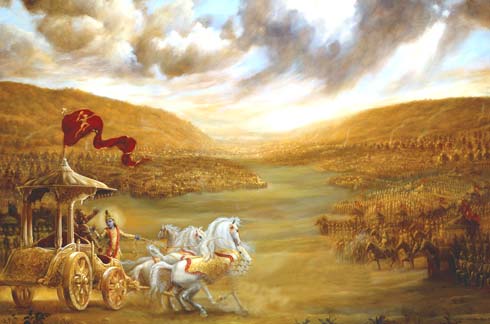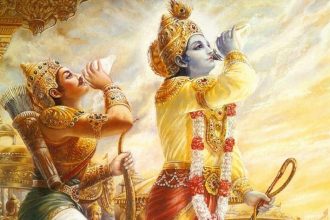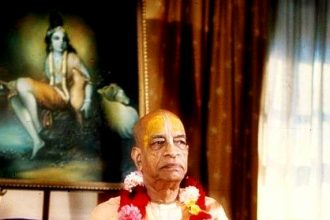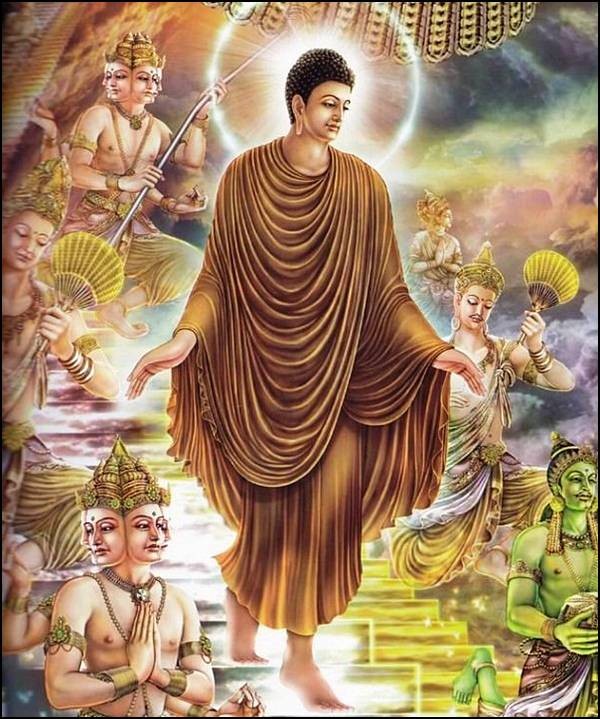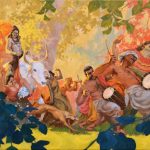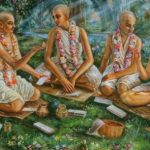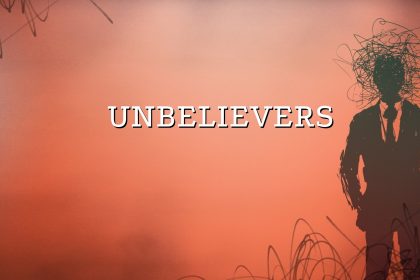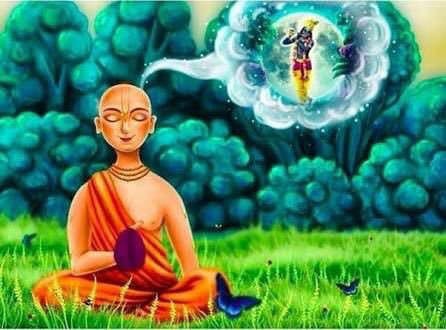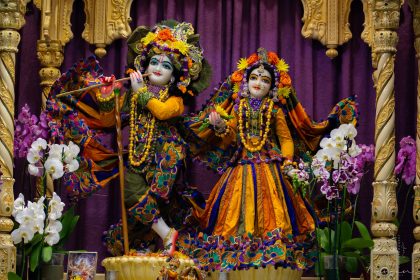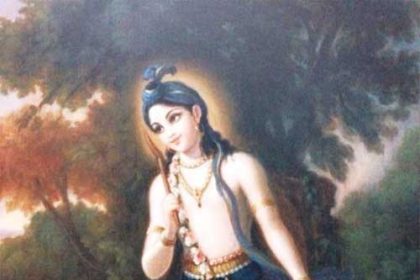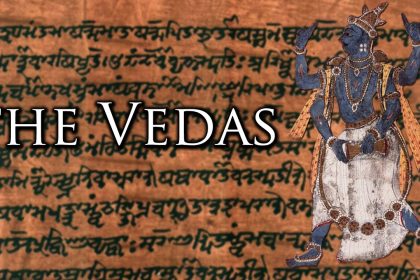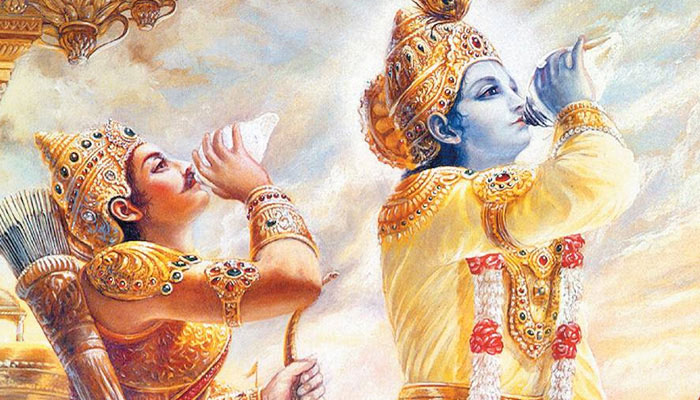By Mayapur-sasi Dasa
Reflections on an article written by Srila Prabhupada in 1956 and on how we as Vaisnavas should think of Lord Buddha today.
In the May 5, 1956, issue of Back to Godhead, Srila Prabhupada published his article “Lord Buddha: The Emblem of Theism.” The opening paragraph informs us of the transcendental poet Sri Jayadeva Acarya’s worship of Lord Buddha. Srila Prabhupada then quotes the poet’s Sanskrit prayer to the ten incarnations of the Personality of Godhead Kesava (Sri Krsna), and then gives this translation: “O my Lord, the Personality of Godhead Kesava! All glory unto You because You have accepted the body of Lord Buddha, who spoke ill constantly of the animal sacrifices in pursuance of the rites of the Vedic literature.”
Srila Prabhupada writes in the purport to the verse that animal sacrifices are sometimes recommended in the Vedas under specific religious rites. He illustrates this point with the story of Lord Caitanya Mahaprabhu’s discussion with Maulana Chand Kazi, the city magistrate of Nabadwip (in Bengal). This occurred in the sixteenth century, two thousand years after Shakyamuni Buddha’s earthly existence. Mahaprabhu asked the Kazi why Muslims kill cows. The learned Kazi replied that cow sacrifice is recommended even in the Vedas, to which Lord Caitanya responded that the recommendations in the Vedas were not for killing, but for giving an elderly cow a new lease on life with perfect health. This was done to demonstrate the powerful Vedic mantras, which when perfectly chanted could perform such wonders. Lord Caitanya then explained that in Kali-yuga this was impossible and therefore cow and horse sacrifices must be avoided.
Before Lord Buddha arrived 2,500 years ago, the sections of the Vedas in which animal sacrifice is discussed were grossly misused, and their performers, Srila Prabhupada comments, “were indulged in an unrestricted extravagance.”
Incarnation Foretold
As stated in the Bhagavad-gita, the Supreme Personality of Godhead incarnates when He sees that false teaching needs to be rectified, or when irreligious behavior becomes intolerable. Lord Krsna therefore appeared as Shakyamuni Buddha to correct the brahmanas’ fallacious teachings about sacrifice.
The Buddha’s incarnation is foretold in the Srimad-Bhagavatam (1.3.24):
tataḥ kalau sampravṛtte
sammohāya sura-dviṣām
buddho nāmnāñjana-sutaḥ
kīkaṭeṣu bhaviṣyati
“Then, in the beginning of Kali-yuga, the Lord will appear as Lord Buddha, the son of Anjana, in the province of Gaya, just for the purpose of deluding those who are envious of the faithful theists.” In the first part of Srila Prabhupada’s purport to this verse, he explains:
Lord Buddha, a powerful incarnation of the Personality of Godhead, appeared in the province of Gaya (Bihar) as the son of Anjana, and he preached his own conception of nonviolence and deprecated even the animal sacrifices sanctioned in the Vedas. At the time when Lord Buddha appeared, the people in general were atheistic and preferred animal flesh to anything else. On the plea of Vedic sacrifice, every place was practically turned into a slaughterhouse, and animal-killing was indulged in unrestrictedly. Lord Buddha preached nonviolence, taking pity on the poor animals. He preached that he did not believe in the tenets of the Vedas and stressed the adverse psychological effects incurred by animal-killing.
According to Buddhist scriptures, Aṣjana was a king of the Koliya dynasty. He had two sons and two daughters. One of the daughters was called Maya, and Maya gave birth to Siddhartha Gautama (Shakyamuni) Buddha in Lumbini, in present-day Nepal. His father’s name was Suddhodana. Gautama Buddha achieved enlightenment at Bodh Gaya in the state of Bihar.
Srila Prabhupada continues:
Less intelligent men of the age of Kali, who had no faith in God, followed his principle, and for the time being they were trained in moral discipline and nonviolence, the preliminary steps for proceeding further on the path of God realization. He deluded the atheists because such atheists who followed his principles did not believe in God, but they kept their absolute faith in Lord Buddha, who himself was the incarnation of God. Thus the faithless people were made to believe in God in the form of Lord Buddha. That was the mercy of Lord Buddha: he made the faithless faithful to him.
Buddhist philosophy appears to be atheistic because there is no acceptance of the Supreme Lord. And yet, as discussed above, Shakyamuni Buddha was in fact an incarnation of Krsna. Srila Prabhupada explains this dichotomy later in his purport to this verse (and in his 1956 article):
Technically Lord Buddha’s philosophy is called atheistic because there is no acceptance of the Supreme Lord and because that system of philosophy denied the authority of the Vedas. But that is an act of camouflage by the Lord. Lord Buddha is the incarnation of Godhead. As such, he is the original propounder of Vedic knowledge. He therefore cannot reject Vedic philosophy. But he rejected it outwardly because the sura-dvia, or the demons who are always envious of the devotees of Godhead, try to support cow-killing or animal-killing from the pages of the Vedas, and this is now being done by the modernized sannyasis. Lord Buddha had to reject the authority of the Vedas altogether. This is simply technical, and had it not been so he would not have been so accepted as the incarnation of Godhead. Nor would he have been worshiped in the transcendental songs of the poet Jayadeva, who is a Vaisnava acarya. Lord Buddha preached the preliminary principles of the Vedas in a manner suitable for the time, and so also did Sankaracarya to establish the authority of the Vedas. Therefore both Lord Buddha and Acarya Sakara paved the path of theism, and Vaisnava acaryas, specifically Lord Sri Caitanya Mahaprabhu, led the people on the path towards a realization of going back to Godhead.
Interestingly, Srila Prabhupada adds in the same purport:
We are glad that people are taking interest in the nonviolent movement of Lord Buddha. But will they take the matter very seriously and close the animal slaughterhouses altogether? If not, there is no meaning to the ahimsa cult.
There are of course different schools of Buddhism. The three main ones are Mahayana (Great Vehicle), Theravada (or Hinayana), Vajrayana (Tibetan/Himalayan, part of the wider Mahayana group). Within those three main groups are many subsects, and the Buddhist cannon is complex, vast, and beyond the scope of this short article.
Buddhists and Meat-eating
Different schools of Buddhism have different views about meat-eating, with pure Mahayana Buddhists being the strictest and completely in line with Vaisnava principles. While slaughterhouses exist in countries with large Buddhist populations, it would be disingenuous to suggest that Buddhists are to blame, as no slaughterhouses exist specifically for Buddhists–because no practicing Buddhist may cause an animal’s death. This is clear in Buddha’s teaching. It may be fairly argued, however, that those Buddhists who do eat meat are unjustifiably and inexcusably hiding under the various regulations about not being “directly” responsible for animals’ deaths, as surely they are still creating the demand for animals to be killed, and this cannot be justified in any form of Buddhism.
Slaughter in the Name of Religion
Tragically we must remember that some countries have persisted in animal slaughter in the name of religious practice–even Nepal, the country of Buddha’s birth. When I lived in Nepal (2008–2011), reportedly five million Hindus from both India and Nepal attended the barbaric slaughter at the Gadhimai festival in 2009. This is held every five years in Bariyarpur, near the border with India. More than twenty thousand buffaloes were sacrificed on the first day alone, and the reader can imagine what a heartbreaking, horrifying, hell-like scene that was.
An estimated 250,000 animals were sacrificed during the Gadhimai festival that year, in the most horrific circumstances. Animal-rights campaigners (some Hindus from India, but others not necessarily connected to any religion, and from all over the world) have strenuously campaigned against this atrocity, but still it continued in 2014 with five thousand buffaloes and a hundred thousand birds and other animals slaughtered, and with hundreds of thousands of Hindus, if not millions, supporting it from both sides of the border. In 2015 the authority overseeing the festival said that these animal sacrifices would cease in the future. We can only hope and pray that this will be so, as these atrocities are exactly what Shakyamuni Buddha was attempting to stamp out.
There is therefore still a great and ongoing need for Buddhists and Vaisnavas alike to continue to preach nonviolence, including towards animals, and to maintain a strictly vegetarian diet.
Other Contributions
It is hard, if not impossible, not to agree that the Buddha contributed greatly to religious practice throughout the world, even to this day. It was primarily due to him that animal sacrifices were greatly reduced, and in many places abolished altogether. Nonviolence, charity, and love and care for other sentient beings were inculcated into the belief of the people, and selfish desires were greatly reduced.
Also, Lord Buddha’s establishment of celibate orders of monks was echoed across Indian religion. Fifty to a hundred years before Shakyamuni Buddha’s time there were already groups of hermits in India living together in what might be called ashrams, but evidence suggests that many more groups did not necessarily follow any unifying communal (monastic) law. It would be true to claim that the Jains had the first true monastic communities, such as the followers of Mahavira in the sixth century. Nevertheless, it seems the flourishing of such communities, with strict monastic laws and common practices, occurred after the establishment of Buddhist monasteries.
In closing, it is also worth noting a few sentences from Srila Prabhupada’s purport to Srimad-Bhagavatam 2.7.37:
Lord Buddha incarnates at a time when the people are most materialistic and preaches common-sense religious principles. Such ahisa is not a religious principle itself, but it is an important quality for persons who are actually religious. It is a common-sense religion because one is advised to do no harm to any other animal or living being because such harmful actions are equally harmful to he who does the harm. But before learning these principles of nonviolence one has to learn two other principles, namely to be humble and to be prideless. Unless one is humble and prideless, one cannot be harmless and nonviolent.
It is beholden on us all therefore to be honest in our reflections about ourselves, and to be genuinely and deeply humble and prideless, no matter what our position in life may be–certainly key qualities that Buddhists and Vaisnavas should share. As Vaisnavas we would say that these are but stepping stones to the great bliss of knowledge of the Supreme Personality of Godhead, Lord Sri Krsna, and the amazing and wonderful personal relationship we can find with Him as we turn our lives to His service, wholeheartedly, humbly, without ego or pride.
The subject of Lord Buddha and how we as Vaisnavas should consider him is a deep, highly complex subject, and the very complexity and depth of Buddhist teaching makes it impossible to discuss in detail in an article of this length. Suffice to say that Lord Buddha, as an incarnation of Lord Vishnu, played a major part in the reformation of religious thought in India 2,500 years ago, and thereafter across the world. When we view him in the light of his being an incarnation of Krsna, working in mysterious and complex ways to restore the Vedic teaching while seeming to refute it, we can only be left in wonder and awe at the Lord’s incredibly wondrous ways.
Mayapur-sasi Dasa was a British army officer and a Buddhist for thirty-three years. He was the most senior rank Buddhist in the British Armed Forces. An initiated disciple of His Holiness Kesava Bharati Dasa Goswami, he is retired, living in Taiwan, painting and writing. He is currently writing three books, two of which are directly in service to his spiritual master.


